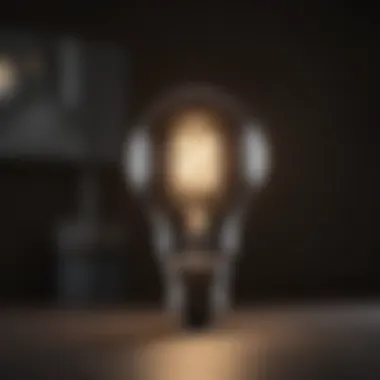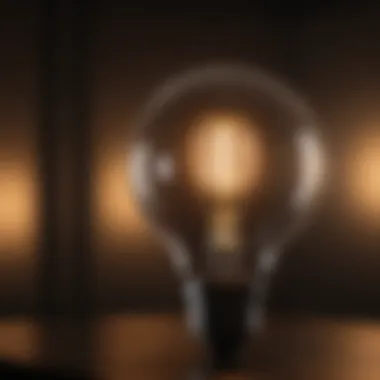Top Light Bulbs to Brighten Dark Rooms Effectively


Intro
Choosing the right light bulbs for dark rooms can significantly affect how a space is perceived. Light can transform areas that are typically uninviting into warm, livable environments. In this article, we will examine various light bulb technologies suitable for low-light settings. By considering aspects such as brightness, color temperature, and energy efficiency, homeowners and design enthusiasts will gain insights to make informed decisions.
Light plays a crucial role in interior design. It not only illuminates spaces but also enhances color palettes and creates moods. This discussion will provide detailed information about the optimal lighting solutions for dark rooms. Understanding different light bulb types will enable you to create comfortable and appealing interiors.
Design Inspiration
Current Interior Design Trends
The current trend in interior design emphasizes the importance of layering light. Designers often prefer a combination of ambient, task, and accent lighting to achieve a balanced effect. In dark rooms, ambient lighting can come from various sources such as ceiling fixtures, floor lamps, and wall sconces. Selecting the appropriate light bulbs for these fixtures is essential.
LED bulbs are gaining popularity for their versatility and efficiency. They can produce warm light, enhancing the coziness of a room. On the other hand, incandescent bulbs offer a traditional glow that many find appealing. Halogen bulbs, a subset of incandescent, provide bright white light, making them suitable for areas needing increased visibility.
Color Palettes and Their Effects
Color also plays a significant role in how light behaves in a room. Darker colors absorb more light, resulting in a dimmer appearance. By opting for lighter colors on walls and furnishings, you can reflect more light, enhancing brightness. When choosing light bulbs, consider their color temperature. The three main categories are:
- Warm White: Around 2700K to 3000K, provides a soft glow, ideal for relaxing spaces.
- Neutral White: Approximately 3500K, offers a balance between warm and cool tones, great for general purposes.
- Cool White: Ranges from 4000K to 5000K, excellent for task-oriented areas where clarity is essential.
In dark rooms, experimenting with different color temperatures can yield various atmospheres. Warmer lights create intimacy, while cooler hues promote focus and energy.
"The right lighting elevates your space, making it feel larger and more inviting."
Foreword to Lighting in Dark Rooms
When it comes to maximizing the utility of dark rooms in homes, proper lighting plays a pivotal role. Inadequate illumination can limit activities, reduce safety, and create an uninviting atmosphere. This section underscores the essence of appropriate lighting selections. It provides insights into how well-designed lighting can transform spaces, making them functional and aesthetically pleasing. Moreover, understanding the role of light can help in mood setting and improving overall well-being.
Importance of Proper Lighting
Proper lighting in dark rooms is crucial for several reasons. First, it enhances visibility, allowing residents to navigate safely without straining their eyes. Bright light can significantly alter the perception of space, making a room feel more open and inviting. Moreover, suitable lighting encourages productivity. For instance, if a person is reading or working in a darker area, insufficient light can lead to discomfort and fatigue. Therefore, choosing the right light bulbs and fixtures can have a direct impact on comfort and functionality.
Secondly, lighting can influence the decor of the room. It highlights architectural features and artwork, giving character to otherwise dull spaces. Implementing different lighting techniques, such as accent or ambient lighting, can bring depth and level to a room, enhancing its visual appeal. This balance of form and function is essential for creating ideal indoor environments.
Lastly, energy efficiency is an important consideration. With the rise of environmentally conscious choices, selecting energy-efficient bulbs like LEDs not only lowers energy consumption but can lead to cost savings in the long run. Adequate lighting can resonate with personal values of sustainability while simultaneously improving the living experience.
Challenges of Lighting Dark Spaces
Lighting dark rooms presents unique challenges. One primary issue is selecting the proper wattage and bulb type to achieve desired brightness. Many homeowners struggle with understanding lumens and how these measurements correlate to effective illumination. Misjudging these aspects can result in either overly bright areas or insufficient light, impacting usability and comfort.
Another challenge lies in color temperature. The spectrum of light can drastically change the mood. Choosing bulbs with the wrong color temperature can make a room feel sterile or unwelcoming. For example, cooler temperatures are often perceived as harsh, while warmer tones can create a cozy environment. Understanding these concepts is vital for effective lighting design.
Additionally, there are practical considerations regarding installation and maintenance. Some light fixtures may require frequent bulb changes or special installation techniques that can deter homeowners from optimizing their lighting solutions. Assessing long-term usability is therefore essential in the selection process. The goal should be to create an atmosphere that not only looks good but serves its intended purposes effectively.
"Illuminating dark rooms requires thoughtful consideration of light type, brightness levels, and maintenance needs."
Understanding Light Bulb Technologies
Choosing the right light bulb for dark rooms is essential for creating the desired atmosphere and ensuring adequate visibility. Understanding various light bulb technologies helps consumers make educated decisions. Different types of bulbs offer unique characteristics and benefits tailored to lighting challenges in low-light environments. This section will delve into four prominent types: Incandescent, LED, Halogen, and CFL bulbs, giving a comprehensive understanding of their functionalities.
Incandescent Bulbs
Characteristics of Incandescent Bulbs
Incandescent bulbs work by heating a filament until it emits light. The light produced is very warm and creates inviting atmospheres, which is particularly suitable for residential settings. One of the key characteristics of incandescent bulbs is their color rendering ability. They provide a natural light quality which many find pleasing. This type of bulb typically has a lower initial cost compared to other bulbs. However, they are less energy efficient and have a shorter lifespan, leading to more frequent replacements. This can mean higher costs in the long run.


Best Use Cases in Dark Rooms
Incandescent bulbs shine best in living spaces where the ambiance is crucial. They are particularly favorable in reading nooks and bedrooms because the warm light promotes relaxation. They tend to perform well in lamps and fixtures where mood lighting is needed. However, their inefficiency limits their effectiveness in larger areas. In darker rooms needing bright light, they might not always suffice.
LED Bulbs
Advantages of LED for Dark Rooms
LED bulbs utilize semiconductors to convert electricity into light. They are highly energy-efficient and can last significantly longer than incandescent bulbs. An important advantage of LED technology is its ability to produce a broad range of brightness and color temperature options. This versatility allows users to tailor the lighting to suit different needs and desired atmospheres. Despite the higher initial price, the efficiency and longevity of LEDs generally result in cost savings over time.
Color Temperature Options
Color temperature describes the appearance of the light emitted by a bulb. LED bulbs offer a wide array of color temperatures, from warm white to cool daylight. Choosing the right temperature is crucial, especially in dark rooms. Warmer color temperatures create a cozy environment, while cooler tones can enhance alertness. This flexibility is a significant advantage, allowing homeowners to select flavors of light that best match their activities and preferences.
Halogen Bulbs
How Halogen Works
Halogen bulbs are a type of incandescent bulb that uses halogen gas to increase brightness and efficiency. They operate similarly but have some advantages, such as providing a whiter light. This technology helps maintain lumens, making them brighter with less energy. Their ability to produce a clear, bright light is beneficial in spaces where attention to detail is important, like kitchens and craft areas.
Ideal Settings for Use
Halogen bulbs are great for task lighting. They work well in focused lighting situations, such as under-cabinet lighting in kitchens or in track lights. While they can effectively illuminate dark areas, they can generate excessive heat, which requires cautious positioning. Hence, their use in enclosed fixtures might not be advisable, as they can pose a fire risk.
CFL Bulbs
Efficiency and Longevity
CFL (Compact Fluorescent Lamp) bulbs are more energy-efficient than incandescent bulbs. They consume less power and have a longer lifespan, offering significant energy savings over time. They achieve this by converting a larger portion of energy into light instead of heat. The key advantage of CFLs is their balance of efficiency and affordability, making them an attractive option for many homeowners.
Drawbacks in Low-Light Areas
However, CFLs have limitations. In darker areas, they may take longer to warm up, and their light may appear less inviting compared to incandescent or LED lighting. Also, the light from CFLs can be less consistent, leading to potential dimness in some instances. Their performance in extensive dimming scenarios is often lacking, making them less applicable in settings requiring variable lighting levels.
Key Features to Consider
When choosing light bulbs for dark rooms, there are several key features that must be considered to ensure that the selected bulbs effectively fulfill their intended purpose. Each feature plays an important role in not just illuminating the space, but also in enhancing the atmosphere and efficiency of the lighting. Here, we discuss brightness, color temperature, and energy efficiency. These qualities are pivotal in creating a well-lit environment in areas that lack natural light.
Brightness Measured in Lumens
Understanding Lumen Levels
Lumen level is a key characteristic to assess when selecting bulbs for poorly lit rooms. Unlike watts, which used to be the standard for measuring light output, lumens indicate the actual brightness of the bulb. Understanding lumen levels helps in choosing bulbs that provide the necessary illumination without being overbearing.
For instance, a bulb with a higher lumen rating will produce more light, making it beneficial for dark spaces. In these environments, a minimum of 800 lumens is often recommended to achieve a bright atmosphere. However, buying bulbs solely based on this count may lead to harsh lighting if not paired with other factors, such as color temperature. Therefore, it is vital to balance brightness with other characteristics for optimal results.
Recommended Lumen Levels for Dark Rooms
In dark rooms, achieving the right brightness is essential. Research suggests that living areas require about 1,500 to 3,000 lumens for comfort and visibility. If using multiple light sources, it is often suggested that the total lumen count be in this range. Choosing bulbs with variable lumen outputs can help fine-tune brightness based on the activity being done, like reading or relaxing.
Another consideration is the placement of bulbs; spreading light sources can reduce shadows, providing effective illumination. This makes adjustable fixtures or dimmer switch options beneficial for flexibility.
Color Temperature
Understanding Warm vs. Cool Lighting


Color temperature, measured in Kelvins, significantly affects the ambiance within a space. Warm lighting (below 3000K) has a soft, yellowish tone suited for cozy settings, while cool lighting (above 4000K) offers a more energetic, bluish hue conducive to workspaces. In dark rooms, the right balance between warm and cool light can change how an area feels and looks.
Choosing bulbs with a color temperature that aligns with room function enhances comfort and productivity. For example, warm light is ideal for bedrooms where relaxation is paramount, whereas cool light may be preferred in kitchens or study areas.
Selecting the Right Color Temperature
Selecting the right color temperature involves considering both the room's purpose and personal preference. For instance, while many may find warm lighting pleasing in a living room, an overly warm light in a work area could lead to fatigue.
Thus, 5000K to 3000K tends to be a common range for general home use, providing a balance between warmth and coolness. This variation allows for adaptability based on changing daily needs.
Energy Efficiency
Comparing Energy Consumption
Energy consumption is another factor critical to light bulb selection. Different bulb technologies such as LED, CFL, and incandescent differ vastly in energy usage. LED bulbs offer exceptional energy efficiency, using about 75% less energy than incandescent bulbs for similar brightness levels. This not only leads to reduced electricity bills but also contributes to an eco-friendly home.
Considering the lifespan of these bulbs can also enhance energy savings. For example, while incandescents may last around 1,000 hours, LED bulbs can last for 25,000 hours or more. This translates to lower frequency in bulb replacements and waste.
Financial Benefits of Energy-Saving Options
Among the significant advantages of energy-efficient bulbs is their impact on monthly expenses. Although the initial cost of LED bulbs may be higher compared to other types, their longevity and energy savings greatly outweigh this. Over time, choosing LEDs can result in up to 80% savings on energy costs, making them a financially prudent choice for any homeowner.
Recommendations for Specific Scenarios
Choosing the right light bulbs involves understanding how different scenarios require different lighting solutions. In dark rooms, the lighting needs can vary significantly based on the activities you intend to do in each space. Whether it is reading, entertaining in the living room, or creating a soothing ambiance in the bedroom, each situation has unique requirements. This section will provide tailored recommendations for different scenarios to ensure you select the most appropriate lighting options.
For Reading Areas
Best Bulb Types for Reading
When it comes to reading, clarity is key. The best bulb types for this activity are typically LED and halogen bulbs.
- LED bulbs are known for their brightness and energy efficiency. They offer clear, focused light that helps reduce eye strain. An important feature of LED bulbs is the ability to choose various color temperatures, allowing readers to select warm or cool lighting according to their preference.
- Halogen bulbs, on the other hand, produce bright, white light that is highly effective in illuminating text without causing fatigue. This makes them a popular choice for reading lamps.
Both options enhance visibility and reduce shadows, making them suitable for dark environments.
Optimal Brightness Levels
The brightness of light is measured in lumens. For reading, an optimal brightness level generally ranges between 800 to 1,200 lumens. This range offers sufficient light for the eyes while preventing excessive glare that can strain them.
Choosing bulbs within this lumen range is beneficial because it provides a comfortable brightness without overwhelming the space. Many LED bulbs now come with adjustable brightness settings, which means you can fine-tune the light output based on your needs.
For Living Rooms
Creating Ambiance with Light
Living rooms serve multiple purposes, from relaxation to entertainment. Therefore, creating the right ambiance with light is essential. Using a combination of ambient, task, and accent lighting could enhance the atmosphere effectively.
- Warm white LED bulbs are excellent for creating a cozy ambiance. They simulate the comforting glow of incandescent bulbs but are much more energy efficient.
- Dimmer switches can offer flexibility by allowing you to adjust brightness levels according to your activities and mood.
This versatility is important as it supports different scenarios, such as hosting gatherings or enjoying quiet evenings.
Recommended Light Fixtures
In dark rooms, the right light fixtures can significantly impact the effectiveness of your lighting strategy. Wall sconces, floor lamps, and table lamps are favored for their ability to direct light strategically.


- Wall sconces can create a soft glow that enhances the room without taking up floor space.
- Floor lamps can add height and drama, while also providing functional light for reading or social spaces.
Each type of fixture can be integrated into your design while meeting your lighting needs effectively.
For Bedrooms
Soft Lighting Solutions
Bedrooms should evoke a sense of calm. Soft lighting is ideal for such an environment. Using dimmable LED bulbs with warm color temperatures can help achieve this effect.
- Such setups minimize harsh lighting, which is often disruptive, especially during nighttime.
- A light that is softer can also aid relaxation and promote better sleep hygiene.
Choosing appropriate fixtures like bedside lamps with shades can enhance this soft lighting effect.
Benefits of Dimmable Options
Dimmable light fixtures provide significant flexibility in how a bedroom is lit. The primary benefit is the control it gives over brightness levels. You can adjust the light according to the time of day or activity.
- For instance, brighter lighting might be useful for reading before bed, while softer, dimmed light can create a relaxing atmosphere for winding down.
- Dimmable options can often be integrated with smart home systems, allowing for even greater control.
This adaptability makes them a worthy investment in enhancing your lighting experience at home.
Installation and Maintenance Tips
Proper installation and maintenance of light bulbs are crucial for achieving optimal lighting in dark rooms. Inadequate installation can lead to safety hazards, while neglecting maintenance can diminish the performance of the bulbs over time. Understanding these aspects helps ensure a safe, efficient, and satisfying lighting experience.
Proper Installation Techniques
When installing light bulbs, follow these steps for best results:
- Turn Off Power: Always make sure the power is off at the switch or at the circuit breaker before beginning installation. This ensures safety and prevents accidents.
- Choose the Right Fixture: Ensure that the light bulb is compatible with the fixture. For instance, some bulbs require specific wattages or bases, like the Edison standard.
- Handle with Care: Avoid touching the glass part of the bulb with your fingers. Skin oils can shorten the lifespan of the bulb, especially with halogen or incandescent types.
- Secure the Bulb: When screwing in the bulb, ensure it is fitted securely but do not overtighten. This can cause breakage.
- Check for Flickering: After installation, turn on the power and check for flickering. If a bulb flickers, it may not be properly seated or there might be an issue with the fixture.
The effective installation not only helps in maximizing brightness but also helps maintain the efficiency of the lighting solutions in dark rooms.
How to Maintain Bulbs for Longevity
Maintaining light bulbs is often overlooked, but it is essential for maximizing their lifespan and performance. Here are some maintenance tips:
- Regular Cleaning: Dust and dirt can accumulate on bulbs, which reduces brightness. Use a damp cloth to clean the bulb gently while it's off and cool.
- Check Connections: If a bulb is flickering or not turning on, check the connections to ensure they are firm and free from corrosion.
- Avoid Frequent Switching: Frequent switching on and off can shorten the lifespan of some types of bulbs, particularly incandescent ones. Use dimmers or timers to manage usage effectively.
- Replace Burned-Out Bulbs Promptly: Waiting too long to replace burnt-out bulbs can lead to uneven lighting. Keeping a few replacements on hand can help maintain a consistent aesthetic in dark rooms.
Proper installation and regular maintenance can extend the life of your light bulbs significantly and improve overall lighting quality.
Understanding how to expertly install and maintain bulbs can transform any dark room into a bright and inviting space.
Through these practices, homeowners and design enthusiasts can ensure that their investment in lighting continues to pay off by enhancing comfort, safety, and style.
Ending
Recap of Best Light Bulb Choices
Ultimately, the choices of light bulbs revolve around several key technologies. Each has its strengths:
- LED Bulbs: Renowned for energy efficiency and long lifespan. Ideal for various applications due to their adjustable brightness and color temperatures.
- Incandescent Bulbs: Provide warm light, making spaces feel inviting. Best suited for areas where ambiance is prioritized.
- Halogen Bulbs: Offer superior brightness and a high color rendering index. They excel in task-oriented settings, making them ideal for workspaces or reading nooks.
- CFL Bulbs: While energy-efficient, they have limitations in low-light conditions and typically warm up slower than other types.
It is essential to match the bulb type with the purpose of the room, considering factors such as brightness, color temperature, and energy use. This will ensure that the lighting is not just functional but also complements the decor.
Final Thoughts on Lighting for Dark Rooms
"A well-lit room can transform not just visibility, but also mood and energy levels."
Therefore, homeowners and design enthusiasts must evaluate their own needs and preferences. Consideration of practicality alongside aesthetic desires will guide in making appropriate selections. Balanced lighting emphasizes the beauty of interiors while offering comfort and usability. Through informed decisions, achieving optimal lighting in dark spaces becomes attainable.















